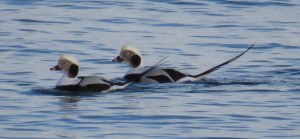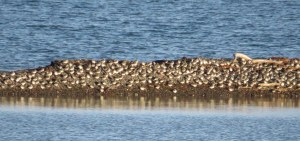Members of our local birding group (Kachemak Bay Birders) met at the base of the Homer Spit on Saturday, November 22 to spend a couple of hours roaming birding hot spots along the Spit while enjoying the sun and warm weather (okay mid 30s, but the wind was calm for most of the trip). At one point, I counted 20 intrepid birders – some of them first timers. We were all energized by the winter sun on our rosy cheeks and birds in our binoculars. No ice covered pools of water or frozen hands for us. Yes, looks like green grass for turkey day. Homer is indeed the banana belt…..
Our group, lead by our always alert leader observed a grand total of 32 species – not a bad day for such a small area.
Our first stop was Mud Bay, famous for its shorebirds and always good for waterfowl in the winter. The duckies were in good shape this year – generally by this time of year we have snow on the ground and ice on the mud flats. Not so this year.
Many of the birds were on the bay and out a ways, so my ability to take decent (or any) photos was limited. Near the Boat Harbor we did spot a large flock of Gray-crowned Rosy-finches flitting about. We only see these birds during the winter months when then come down from their breeding grounds in alpine areas. There are six subspecies of Gray-crowned Rosy-finches (Leucosticte tephrocotis) of which four breed in Alaska.
When the weather is really nasty (blowing snowy and cold), these birds come to our home feeder in droves (up to 250 or so). Most times they are seen mainly on the Homer Spit.
Some, okay all of us, were hoping the Snowy Owl spotted earlier in the week would make an appearance, but we head to settle for a different snowbird – Snow Buntings. Not to be sneezed at, these are pretty cool birds too. There was a flock of 20+ buntings at Green Timbers searching for food among the grass and driftwood. We only see these birds during the winter also. In the summer they nest in the high arctic.
Did you know the male Snow Bunting undergoes only one molt in the fall? So how come they look so different in the summer ? Well the male wear off all of the feather tips by rubbing them in the snow. By the breeding season the male’s feathers are white and black. For photos of Snow Buntings in the summer check out: http://www.allaboutbirds.org/guide/Snow_Bunting/id.
On the bay there were some Long-tailed Ducks (formerly known as Old Squaw). I love their call (check out: http://www.allaboutbirds.org/guide/Long-tailed_Duck/sounds), and these guys were calling. While I was able to get a few photos, the photos do not do the birds justice (camera limitations and distance of bird from the shoreline).
This diving duck breeds in the high arctic and winters along the coasts of the United States. A good size flock generally spends the winter in Kachemak Bay, particularly along the spit where food from fish processing plants is plentiful at times.
Of course what is the Spit without its resident Bald Eagle population. This Bald Eagle was enjoying an afternoon meal upon a metal dolphin near the tip of the spit (Land’s End for those in the know).
We also found a flock of Rock Sandpipers roosting along a berm. Rock Sandpipers are one hardy bird – we enjoy them all winter long. They often roost inside the calm water/banks of the Homer Small Boat Harbor, and even as the boat harbor freezes up the birds can be found there taking a bath.
Here is a list of the species we saw on our field trip:
COMMON LOON
RED-NECKED GREBE
HORNED GREBE
PELAGIC CORMORANT
HARLEQUIN DUCK
EURASIAN WIGEON
AMERICAN WIGEON
COMMON GOLDENEYE
GREEN-WINGED TEAL
MALLARD
LONG-TAILED DUCK
NORTHERN PINTAIL
WHITE-WINGED SCOTER
BLACK SCOTER
SURF SCOTER
GLAUCOUS-WINGED GULL
MEW GULL
BLACK-LEGGED KITTIWAKE
COMMON MURRE
MARBLED MURRELET
PIGEON GUILLEMOT
ROCK SANDPIPER
BALD EAGLE
ROCK PIGEON
BLACK-BILLED MAGPIE
NORTHWESTERN CROW
COMMON RAVEN
BOREAL CHICKADEE
GOLDEN-CROWNED KINGLET
SONG SPARROW
GRAY-CROWNED ROSY FINCH
SNOW BUNTING
If you want to learn more about the Kachemak Bay Birders, check out their website at: http://kachemakbaybirders.org/. The group’s next scheduled field trip is set for January 17th – Leader’s Choice (so it could be almost anywhere). Interested persons should meet at the Islands and Ocean Visitor Center parking lot at 12:00 – noon.













Leave a Reply